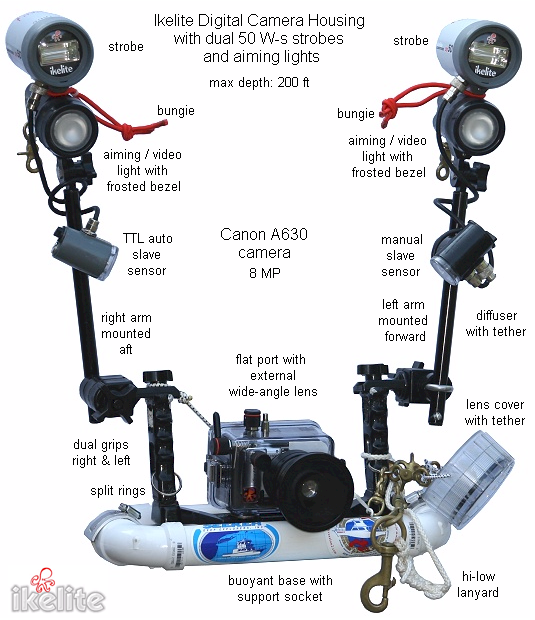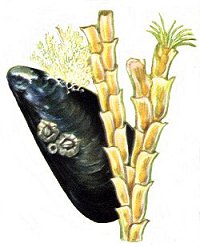Underwater Photography & Video
Underwater photography can be as rewarding as it is challenging. Once the realm of professionals and determined enthusiasts willing to spend thousands of dollars on specialized and esoteric equipment, this hobby is now available to the rest of us thanks to modern developments in inexpensive but capable digital systems.
2016 Update
There is no hope of keeping up with camera technology. This page is more about basic principles than the actual equipment, which will all be obsolete in six months. Actually, strobe lights haven't changed that much.
Human Vision Underwater
When light travels from a less-dense medium like air to a more-dense medium like water, the rays are refracted or bent towards the normal or perpendicular of the surface between the two mediums. In crude terms, light going from air to water will tend to be straightened, while light going from water to air will tend to be ... um ... crookeded. Confused yet? Take a look at the figure below.
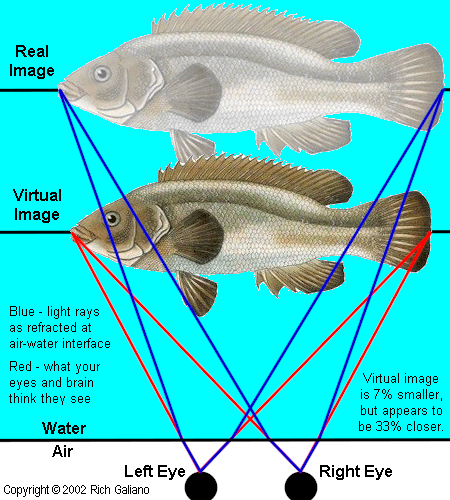
In this figure, you can see the light rays traveling from an object in the water to your eyes, neglecting the effect of the flat glass lens of your mask. The blue lines trace the actual path of the light rays through the water and into the air, or conversely, through the air into the water - the direction really doesn't matter. As you can see, the rays are bent toward the perpendicular of the surface on the water side, and away from it on the air side.
More: Light, Air & Water ...

Photography is all about light. Good lighting is the single most important factor in getting good pictures. After that, technique, experience, and artistic composition are second, and fancy expensive equipment is a distant third.
Unlike photo equipment, light is generally free, during the day anyway. For good results, you usually want to collect as much of it as possible for every picture. This is the job of your camera's lens. The lens is the most important part of a camera, and it is ironic how manufacturers of SLR systems with interchangeable lenses generally sell kits with fancy expensive bodies ( lots of buttons, etc ) and cheap lenses. Even more ironic, much low-end photography is done with disposable cameras that have no lens at all! Whether you use a point-and-shoot, a digital, or an SLR, make sure your camera has a good lens on it. Secondarily, shutter speed also affects your light-collecting ability. Better cameras have controllable shutters, while point-and-shoots are usually fixed at around 1/100 second.
More: Underwater Photography In General ...
Having acquired all your nice expensive equipment, you may want to insure it against damage and flooding. Alright, perhaps not a cheap film camera, but a high-end housed 35mm, digital, or video camera certainly deserves the protection. On the other hand, with proper care and maintenance, and attention to detail when sealing it up, a modern camera housing is extremely unlikely to leak.
Here's something I learned the hard way:
Batteries + saltwater = one really nasty corrosive mess. Regular old alkalines are not nearly as destructive when you get them wet. What does this mean? Use NiMH batteries in the camera inside the housing, but use alkalines inside your strobes, so that if the battery compartment does flood, you can just rinse it out with fresh water and maybe lemon juice. The result of a wet NiMH battery will eat away the metal contacts of the battery compartment so fast that by the time you can do anything about it, it's too late. Alkaline batteries have plenty of oomph to drive a strobe, although not a camera. If your camera housing floods, the battery type won't really matter, since the saltwater will destroy the camera all by itself.
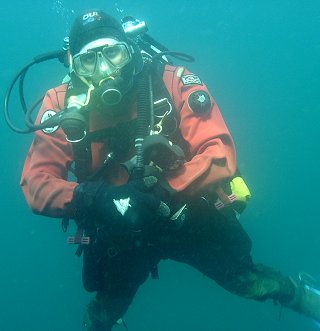
Digital camera technology is progressing at a phenomenal rate. Much like computers, prices steadily fall, while features and performance improve. When setting up an underwater digital photography system, first make sure you have the very best and latest top-of-the-line digital camera available. Don't buy a housing for a camera that is already old, or you will find yourself stuck with an expensive combination that is already obsolete, or very soon will be. Get a new camera first, then get a housing for it.
More: Digital Cameras ...
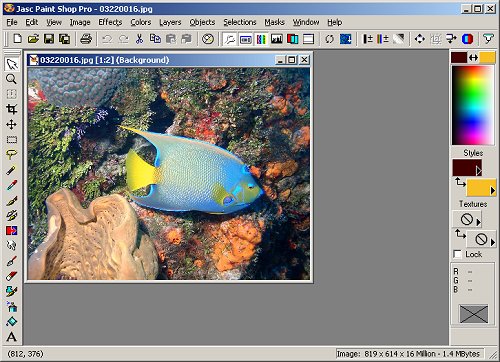
One of the great advantages of digital photography is the ease with which the resulting photos can be manipulated and improved later using your computer and an image editing program. Of course, you can also do this by scanning film prints or slides, but dealing directly with digital images is faster, easier, and virtually free.
Underwater photos ( film or digital ) may suffer from the following problems:
- lack of contrast
- lack of sharpness
- excessive darkness or light
- loss of red tones / poor color balance
- poor framing and composition
More: Digital Image Editing Software ...
Close-up & Flash
By well-lit, what I mean is situations that fall within the normal range of your camera's exposure program. This is a combination of ISO (film) speed, shutter speed, and aperture which will result in capturing a desired image. On land, such situations occur all day long, but underwater they are rare. Clear shallow water with a bright sun shining overhead is the only environment in which your camera is likely to work unaided, as it would topside.
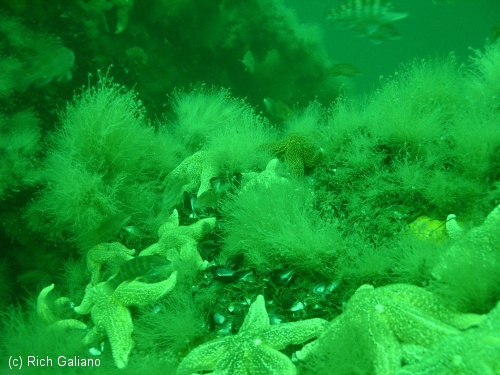
An unremarkable ambient light test shot, at a depth of about 100 ft. Note the loss of colors, even close-up. Flash would bring out all the hidden colors.
More: Photography - Well-lit Situations ...
Wide-Angle & Ambient Light
All modern automatic cameras use an internal "program" to determine correct exposure settings. The inputs to this program are:
- camera lens aperture range
- camera shutter speed range
- light level
- film speed or ISO
- flash mode
- operator's desire ( such as for a portrait. )
More: Photography - Poorly-lit Situations ...
One day, when conditions were marginal for still photography, I put my little camera in video mode, just to see what it could do. Was I ever surprised at the result! Here is the first underwater video I ever shot:
This was originally shot at the highest quality settings that the camera had - 640x480 resolution, 30 frames per second. The camera offers no other controls - just start and stop - so shooting is pretty much a no-brainer.
More: Underwater Video ...
When just floating around isn't enough ...
- Photography & Video ...
- Lobstering ...
- Spearfishing ...
- Collecting Shellfish ...
More: Diving Activities ...

